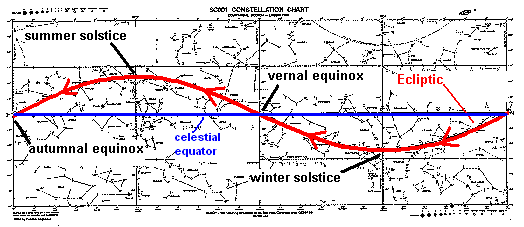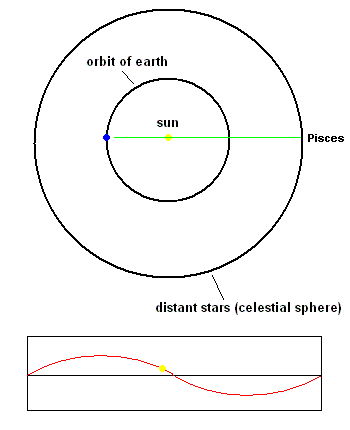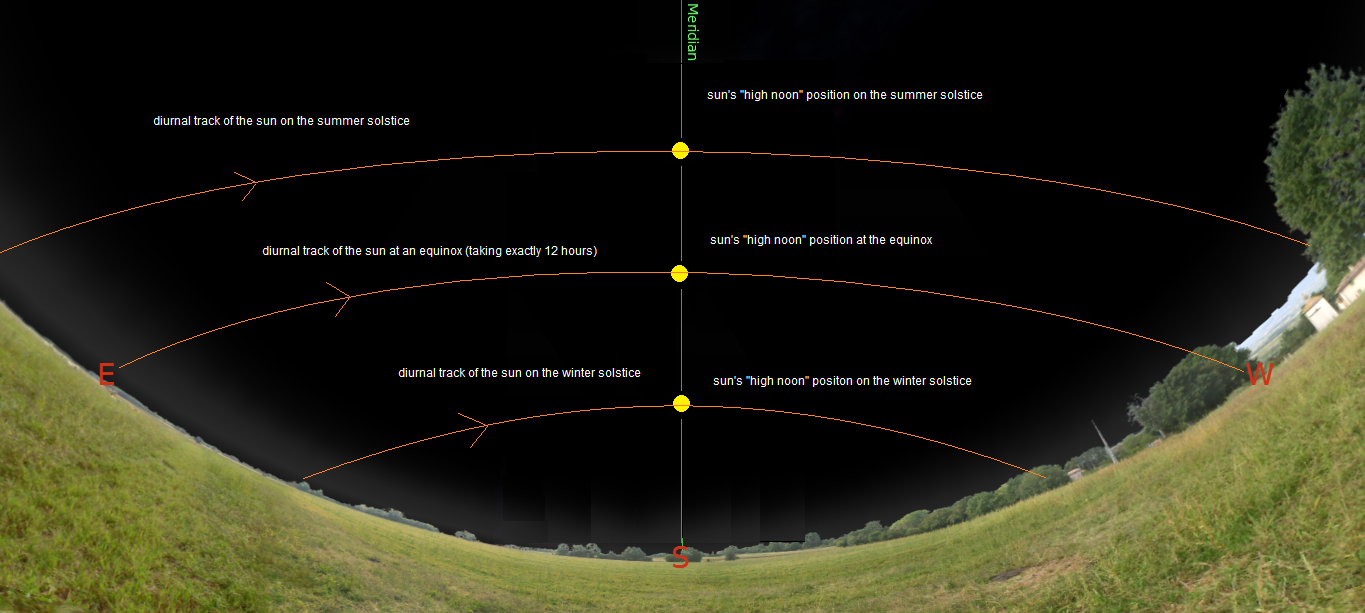Seasonal cycles - You have lived on the earth long enough to notice some longer term cycles which require one year to complete. The first one you notice are the 4 seasons - winter, spring, summer, and fall. There are specific changes in the climate that Wisconsinites are all too familiar with. A keen observer will also notice specific seasonal changes occurring in the sky as well. The most obvious is the length of the day in summer vs. winter. In Milwaukee, the longest day is around June 20 or 21 when we get just over 15 hours of sunlight (but only just under 9 hours of sunlight on December 21 or 22). A more careful observer will also notice that the sun's daily path through the sky is radically different at these same times.
For example, on June 20 or 21 in Milwaukee, the sun rises about 33 degrees north of due east ... makes a great arc across the sky (coming just 20 degrees short of zenith at noon ... and setting 33 degrees north of due west. But on Dec 21 or 22, the arc of the sun is just barely above the horizon all day (only getting about 24 degrees above the southern horizon at noon). Finally, the most keen observer will observe that certain constellations are visible at certain times of the year. For example, the constellation Orion is only seen during the winter months, and Sagittarius is only seen during the summer.
|
|
|
Watch the sun rise in Milwaukee at different times of the year. The file is large .wmv format (3 MB) OR .mp4 format (2 MB).
Watch the entire day in Milwaukee in winter vs. summer. .wmv format (2 MB) OR .mp4 format (2 MB)
Stellarium users can see this by setting the location to Milwaukee on 12/21 (any year). Look south and zoom out so you can see past the eastern and western horizon markers. Remove the atmosphere and display the azimuthal grid for reference. Now watch a day go by and pay attention to the path of the sun. Change the day to 6/21 and repeat. You should notice a big difference.
Why does this happen?
This is all a result of the earth's revolution around the sun (with a tilt of 23½ degrees).
On March 20 or 21 and September 23 or 24 (the first days of spring and autumn) the sun shines directly over the equator. On June 20 or 21 (the first day of summer in the NH) the sun shines 23½ degrees above the equator on the Tropic of Cancer. Finally, the suns rays shine 23½ degrees below the equator on December 21 or 22 which is the Tropic of Capricorn.
You already know that the sun does not remain fixed in the sky because the earth rotates on its axis. But even the ancient Greeks were aware that the sun does not remain fixed in any one constellation ... but moves along 12 constellations known as the zodiac. It takes a full year for the sun to traverse this path. Technically, this path is called the ecliptic. This is actually a circle around the sky which indicates the path of the sun throughout the year. Your SC001 star map depicts the ecliptic as a wavy line (much like a sine wave) ... but it is actually a great circle in the sky which is tilted 23˝ degrees to the celestial equator. The SC001 map has date marking along the ecliptic which pin-points the exact location of the sun for any day of the year. It shows that the sun moves eastward along the ecliptic (as measured against the stars)... taking a full year to make one trip around the celestial sphere.
Along the way, the sun crosses some points of interest. On March 20 or 21 the sun crosses the vernal equinox. There isn't anything interesting there except that this is where the ecliptic intersects the celestial equator (the other point is the Autumnal Equinox on September 23 or 24). The sun also crosses the summer solstice on June 20 or 21 and the winter solstice on December 21 or 22.

Stellarium users can observe the same thing. The easiest way is to remove the ground and atmosphere and center the sun on the screen. Draw in the ecliptic and label the constellations as well as their names. Now toggle the date ahead one day at a time. You should notice the sun's position shifts relative to the constellations of the zodiac. Notice that the sun is moving eastward (to the left) relative to the fixed stars. If that isn't clear, go to August 1st (any year) and lock on the star Regulus. Toggle the day forward one day at a time and watch how the sun moves relative to Regulus.
The sun moves eastward along the ecliptic ... taking one year to complete an orbit.
If possible, please view a 115 kb movie in AVI format which shows the sun moving along the ecliptic by clicking here. The file is large .wmv format (2 MB) OR .mp4 format (2 MB).
It should be clear that the motion of the sun along the ecliptic is really an illusion. Just as the rising and setting of the sun is caused by the rotation of the earth on its axis ... the motion of the sun along the ecliptic is caused by the earth's revolution around the sun.

This animation shows you why the sun moves along the ecliptic.
You should also see why some constellations are not visible to us at certain times of the year. Try to find Pisces around March 21. You can't because the sun is in that constellation at that time. Can you guess what time of the year Pisces is best seen?
Since it takes a full year for the earth to orbit the sun, it should be no surprise that it takes the same time period for the sun to trace out the ecliptic. It should also be clear why the sun is on the celestial equator two times of the year ... March 20 or 21 and September 23 or 24! These are the two days the sun's rays are shining directly over the equator and the sun is at one of the equinoxes.
When the sun crosses the vernal (and autumnal) equinox , every point on earth receives 12 hours of daylight and 12 hours of darkness. This marks the first day of spring (or fall). These two days were noticed by almost all ancient cultures and treated accordingly. In most cases, huge sun calendars were constructed in the form of temples, pyramids or obelisks to predict (using shadows) when these two days would occur. It was generally regarded as a holy or sacred day ... or a day where balance was found in the universe.
On June 20 or 21, the Northern Hemisphere is enjoying its summer because the tilt is directed toward us. The sun is 23½ degrees above the celestial equator. On this day the sun makes a huge arc across the sky, and the day is very long.
The sun is 23½ degrees above the Celestial Equator on June 20 or 21.
In summer, the sun rises in the far north-east in Milwaukee
On December 21 or 22, the Northern Hemisphere is tilted away from the sun, and we have a very short day. The sun is 23½ degrees below the celestial equator, so the path of the sun on this day will not be very high in the sky.
On December 21 or 22, the sun is very low in the sky in Milwaukee
In winter, the sun rises in the far south-east in Milwaukee

The sun's position (and daily path) changes throughout the year as seen in Milwaukee
In the image above, notice that the sun rises exactly due east and sets due west at an equinox. It is above the horizon for exactly 12 hours. On the winter solstice, the sun is much lower in the sky and the arc it takes throughout the day is very short ... hence, less hours of daylight. The opposite can be said about the sun when it is at the summer solstice. The huge arc it takes throughout the day results in many more hours of daylight. In addition, the rays of the sun enter the atmosphere at a much more direct angle (resulting in more intense surface heating). The result is why we have warmer temperatures ... time to fire up that BBQ.
The seasonal changes in the sky become more exaggerated as you move to higher latitudes. Anyone living in Canada will tell you that in summer the days are longer and the nights are shorter than as seen in Milwaukee. In winter they hardly ever see the sun because the nights are so long.
On March 21, if you live anywhere within the Arctic circle (a ring 23˝ degrees from the north pole), you will see the sun all day long. If you live within the Antarctic circle, you will experience a day of darkness. These roles are reversed on September 24.
The most extreme case occurs when you reach the north (or south) pole.
If you happen to live at the north (or south) pole, life gets very interesting! Recall that at the earth's poles, all stars are circumpolar (never rise or set). The celestial pole is at your zenith, and the celestial equator defines your horizon. Except for the night Santa takes his sleigh ride, Old St. Nick only gets to see the northern half of the celestial sphere, but it gets even stranger. The sun is above the celestial equator from March 20 or 21 till September 23 or 24. That means the sun is "up" for a whole 6 months. It cracks the horizon on that day (March 20 or 21st) and moves along the horizon all day. Each day it moves a little higher in the sky ... reaching 23½ degrees above the horizon on June 20 or 21 ... then it slowly moves closer to the horizon. It sets on September 23 or 24 and is not seen for another 6 months. Talk about cabin fever!
Use Stellarium to take a trip to the north pole (set your latitude to N 90) and remove the atmosphere.. Watch a day go by. Observe how the stars move. Now pay attention to the sun (you may even want to reinstate the atmosphere). You will want to observe at different times of the year. Life is crazy for Santa! Then repeat the observation from the equator (latitude 0) .
If all this material is a bit confusing to you ... you are not alone. This is because the earth has two separate motions in space, and each one causes different changes in the sky ... and both are occurring at the same time. So let's see if we can filter through this madness and review this logically. The earth rotates on its axis ... causing a 24 hour day/night cycle in the sky. This makes the sun appear to move westward in the sky rather quickly. The earth also revolves around the sun with a 23˝ degree tilt. This causes the seasons and also makes the sun appear to move eastward against the constellations. This motion is much more subtle ... taking a full year for the sun to make one trip along the ecliptic.
You should also see why the number 23˝ shows up so often in this page. It really boils down to the tilt of the earth (as it goes around the sun)! As a result:
Without this tilt, every day would be 12 hours of daylight and 12 hours of night for all locations. If the tilt were more extreme, the seasonal shifts would also be more extreme ... maybe too much to support life!
ŠJim Mihal 2004, 214- all rights reserved